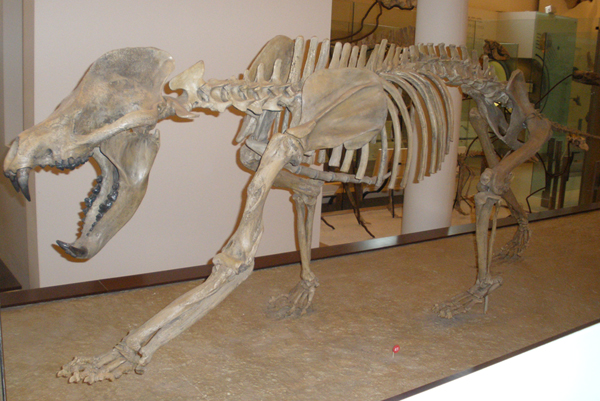Bear dogs, or Amphicyonidae, were representatives of an extinct family of carnivorous mammals that lived during the Miocene Epoch. They possessed peculiar features because they combined some aspects of modern bears and dogs; hence, this name was attached to them. Fossils of bear dogs were found in parts of the world; one is Barstow Fossil Beds in California, which is also an important center for paleontologists studying the ancient ecosystems of North America.

Physical Characteristics:
Size: They were very varied in size, from the smallest, which was about the size of modern foxes, to the largest, which rivaled grizzly bears in size and strength.
Appearance: Bear-like bodies, but with powerful jaws and sharp teeth adapted for hunting, while their legs were longer and more dog-like in structure, running and chasing their prey.
Diet: These were carnivorous animals that probably preyed upon smaller mammals and did so perhaps by ambush and endurance hunting, just like the big cats or wolves of today do.
Barstow Fossil Beds: These fossil beds, if situated within the Mojave Desert, have yielded a wide variety of prehistoric animal remains, including those of bear dogs. This is a formerly much more lush environment with forests, rivers, and wetlands that support diverse wildlife.
Miocene Environment: When bear dogs ranged into the Barstow area, it was a temperate region teeming with ancient species such as early horses, camels, rhinos, and mastodons. Bear dogs were likely top predators in this ecosystem.
Evolution: The various fossil discoveries in Barstow will help scientists trace the evolution of flesh-eating mammals. The bear dogs belonged to the early lineage that gave rise to present-day bears, dogs, and all other large predators.
Extinction: Bear dogs flourished for millions of years but died out toward the end of the Miocene Epoch. Their extinction may be related to climate changes and competition with other carnivores, ancestors of modern cats and wolves, which were better adapted to changing environmental conditions.
Importance of the Barstow Fossil Discoveries:
Fossils like bear dogs found around Barstow give rare glimpses into an ancient world. Such finds enable paleontologists to reconstruct the ancient ecosystems of North America and learn more about how animal species, including early carnivores, adapted and evolved.
The bear dog fossils from near Barstow point to the emergence of very diversified ecosystems in which the bear dogs were among the top predators of their time. Their fossils are an important determinant that leads to unraveling their biology and the environment to which they belonged millions of years ago.